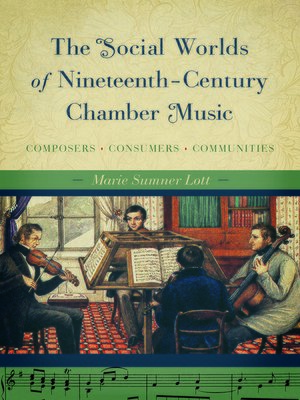The Social Worlds of Nineteenth-Century Chamber Music
ebook ∣ Composers, Consumers, Communities
By Marie Sumner Lott

Sign up to save your library
With an OverDrive account, you can save your favorite libraries for at-a-glance information about availability. Find out more about OverDrive accounts.
Find this title in Libby, the library reading app by OverDrive.



Search for a digital library with this title
Title found at these libraries:
| Library Name | Distance |
|---|---|
| Loading... |
Marie Sumner Lott examines the music available to musical consumers in the nineteenth century, and what that music tells us about their tastes, priorities, and activities. Her social history of chamber music performance places the works of canonic composers such as Schubert, Brahms, and Dvoøák in relation to lesser-known but influential peers. The book explores the dynamic relationships among the active agents involved in the creation of Romantic music and shows how each influenced the others' choices in a rich, collaborative environment. In addition to documenting the ways companies acquired and marketed sheet music, Sumner Lott reveals how the publication and performance of chamber music differed from that of ephemeral piano and song genres or more monumental orchestral and operatic works. Several distinct niche markets existed within the audience for chamber music, and composers created new musical works for their use and enjoyment.
Insightful and groundbreaking, The Social Worlds of Nineteenth-Century Chamber Music revises prevailing views of middle-class influence on nineteenth-century musical style and presents new methods for interpreting the meanings of musical works for musicians both past and present.
| Cover Title Copyright Contents List of Figures and Tables List of Musical Examples Acknowledgments Introduction. String Chamber Music and Its Audiences in the Nineteenth Century 1. Publishing Chamber Music: Archival Evidence for Chamber Music Production and Consumption 2. "Domesticating" the Foreign in Arrangements of Operas, Folk Songs, and Other Works for Chamber Ensembles 3. Music for Men of Leisure: An Examination of the Domestic String Style 4. Redefining the "Progressive" Style in Responses to Beethoven's Late Quartets 5. Creating "Progressive" Communities through Programmatic Chamber Music 6. Audience and Style in Brahms's String Chamber Music 7. The Diversity of Dvořák's String Quartet Audiences Appendix 1 J. Strunz, string quartet transcription of no. 18, "Prière" (Prayer), from Meyerbeer's Robert le Diable Appendix 2 C. W. Henning, string quartet transcription of no. 8, "Leise, leise, fromme Weise" (Gently, gently, pious words), from Weber's Der Freischütz Appendix 3 M. Kässmayer, string quartet arrangement of "Mein Herz ist im Hochland" (My heart is in the Highlands) from Deutsche Lieder, op. 14, no. 4 Notes Bibliography Index |"By focusing on the milieu of middle-class amateurs rather than the professional world of the concert hall that has occupied most scholars, Lott provides a fresh perspective on the production and consumption of chamber music in nineteenth-century Europe. The Social Worlds of Nineteenth-Century Chamber Music is an exemplary contextual study that enhances our appreciation of not only canonic masterworks but also lesser-known pieces written for this thriving market."—Walter Frisch, author of Music in the Nineteenth Century"Marie Sumner Lott's monograph, The Social Worlds of Nineteenth-Century Chamber Music: Composers, Consumers, Communities, takes us on a rewarding journey into chamber music's often hidden social worlds, adopting an approach accessible to a broad readership." —Victorian Studies
"This book is an extremely significant achievement. It is likely to attract the interest of a broader readership and is strongly recommended, both as a resource for students...







